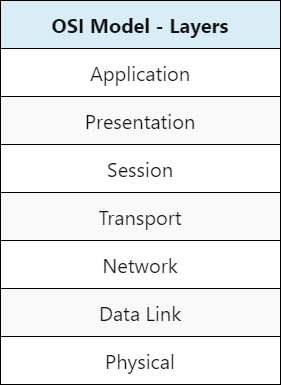In this article, we will discuss the OSI (Open System Interconnection), Model of computer networking. It is a reference model that is designed to understand large and complex network architecture in a simple layered approach. OSI model itself does not have any direct relationship with the network. It defines a networking framework where various networking protocols work in different layers.

History of Open System Interconnection – OSI Model
In 1970, we had several network communication protocols but they were designed for the same types of machines. For example, IBM machines could communicate only with IBM machines, and similarly, AppleTalk is designed for Macintosh computers.
In 1978, ISO (International Standard Organisation) started working to develop a network reference module. In 1984, finally, a reference model was developed and this is known as Open System Interconnection.
OSI model has 7 different layers. Each layer has different functions. Different types of protocols work on different layers.
7 Different layers of the Open System Interconnection (OSI) Model
As we already discussed, the OSI Model has 7 different layers. In this session, we will cover all these layers.

Application Layer
This is the 7th protocol of the OSI Model. In this layer, different protocols have directly interacted with the user application. On this layer, various protocols work. They encapsulate their header on this layer. After the encapsulation, they hand over this data to the presentation layer.
Examples: HTTP, HTTPS, FTP, RIP, DNS, DHCP, BGP, etc.
Presentation Layer
This layer is the 6th layer of the OSI Model. In this layer, various operations are performed on original data from the application layer. Here, mainly Data Encryption, Data Decryption, Data conversion, Compression, and Serialization operations are performed on the original data. After performing the various operations, it handovers this data to the Session Layer.
Session Layer
The Session Layer is the 5th layer of the OSI model. This layer maintains sessions between different computers. The session layer is responsible for session creation, session managing, and session termination between different computers. This layer is also important for session checkpointing and recovery. After the creation or termination of data, it is handover the data to the transport layer (described below).
Transport Layer
The transport layer is the 4th layer of the OSI model. In this layer, two major protocols TCP and UDP work. This layer chucks the actual data into segments and then encapsulates their headers on this. After the encapsulation process, it handover this segment to the network layer on which Internet Protocol (IP) protocol is working.
Ports: Port is a virtual path from source to destination. Both protocols TCP and UDP, have two 16-bit fields which are known as Source Port and Destination Port. Protocols at the application layer have their pre-defined port numbers. These port number is also known as “Well-defined ports“. During the transmission of data, a sender will choose a random port number in the Source Port field and a well-defined port in the Destination field during the initial communication.
Network Layer
The network layer is the 3rd layer of the OSI model. In this layer, Internet Protocol (IP) works. This layer receives data from the Transport layer. Here, IP protocol encapsulates their header on received data and thus forms a data packet. The IP protocol, here mainly adds source and destination IP addresses. This data packet is further sent to the Data Link Layer of the OSI model.
Protocols: IPv4, IPv6, EIGRP, OSPF.
Data Link Layer
The Data Link layer is the 2nd layer of the OSI model. This layer is responsible for node-to-node data transfer. This layer has two sub-layer.
Medium Access Control (MAC) layer: Responsible for how devices gain access to transmit data over a medium.
Logical Link Control (LLC) layer: It is responsible for identifying and encapsulating Network Layer protocols. It is also used for error checking and error correction.
Example: On the data link layer, IEEE standards 802.3, i.e., Ethernet, and 802.11, i.e., Wi-Fi work.
Physical Layer
This is the first protocol of the OSI model. This layer is responsible for sending and receiving data bits from one end to another end.
Example: Here, Transmission media like Wire, RJ45, etc works.
Related Articles
- Difference between TCP/IP and OSI models
- UDP | User Datagram protocol – Explained in detail
- TCP | Transmission Control Protocol – Explained in detail
- Transmission Control Protocol Internet Protocol (TCP/IP) Model
Summary
OSI (Open System Interconnection), is a reference model developed by ISO (International Standard Organisation) in 1984. This model has 7 different layers. Each layer has different protocols. It is very helpful for understanding data flow between computers.
Did you find this article helpful? Please share it on social media platforms and show us some love :).